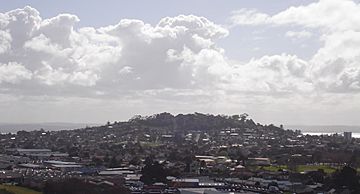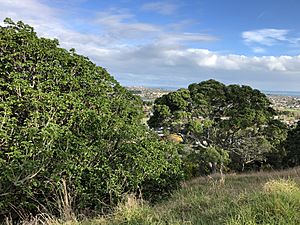Mount Albert (New Zealand) facts for kids
Quick facts for kids Mount Albert |
|
|---|---|
| Ōwairaka or Te Ahi-kā-a-Rakataura | |

Mt Albert volcano in the Mt Albert suburb.
|
|
| Highest point | |
| Elevation | 135 m (443 ft) |
| Geography | |
| Location | North Island, New Zealand |
| Parent range | Auckland volcanic field |
| Geology | |
| Volcanic arc/belt | Auckland volcanic field |
Mount Albert, also known by its Māori names Ōwairaka or Te Ahi-kā-a-Rakataura, is a volcanic hill. It stands out in the landscape of Mount Albert, a suburb in Auckland, New Zealand.
Contents
Understanding the Names of Mount Albert
Mount Albert received its English name in 1866. It was named after Prince Albert, who was the husband of Queen Victoria. This happened after people asked the leader of Auckland Province, Frederick Whitaker, to name it after him.
The Māori Name Ōwairaka
The main Māori name for the peak is Ōwairaka. This means 'Place of Wairaka'. Wairaka was the daughter of Toroa, a famous leader. Toroa commanded one of the great voyaging canoes called Mātaatua.
Wairaka is well-known for naming Whakatāne, a town in the Eastern Bay of Plenty. She saved her canoe from floating out to sea there. You can see a statue of Wairaka in Whakatāne Heads. Later, Wairaka moved to Tamaki-Makaurau (Auckland) to avoid an arranged marriage. She built her own fortified village, called a pā, at Ōwairaka.
The Māori Name Te Ahi-kā-a-Rakataura
Another Māori name for the mountain is Te Ahi-kā-a-Rakataura. This name refers to Rakataura, also known as Hape. He was a priest from the Tainui canoe.
Exploring Mount Albert's Geography
Mount Albert is located in a park at the southern end of the suburb. It is about 135 meters (443 feet) tall. It is one of many old volcanoes found across the city of Auckland. All these volcanoes are part of the Auckland volcanic field. We don't know exactly how old this volcano is.
In the past, the peak was home to a Māori pā, which was a fortified village. Over time, a lot of rock was removed from the mountain through quarrying. This reduced its height by about 15 meters (49 feet) and changed its shape. However, you can still see some parts of the old Māori earthworks, like flat terraces.
Today, the mountain is used for different activities. It has several sports fields and an archery club. There is also a large water reservoir, about 31,500 cubic meters (1.1 million cubic feet) in size, buried under a field on the mountain's southern side.
Understanding the Treaty Settlement
In 2014, an important agreement was made. This was part of the Treaty of Waitangi settlement. The agreement was between the Crown (the New Zealand government) and a group of 13 Auckland iwi (tribes) and hapu (sub-tribes). This group is called the Ngā Mana Whenua o Tāmaki Makaurau collective, or the Tāmaki Collective.
Through this settlement, the ownership of Ōwairaka / Te Ahi-kā-a-Rakataura / Mount Albert was given to the collective. Now, the mountain is managed together by the collective and the Auckland Council. This is done through a group called the Tūpuna Maunga o Tāmaki Makaurau Authority. They manage the mountain for the benefit of the iwi and all other people in Auckland.
Changes to Vehicle Access
The mountain, or maunga, is very important to Māori people for spiritual and cultural reasons. Because of this, the road to the top of the mountain was permanently closed to most vehicles in March 2019. This helps protect the mountain's special significance.
Native Tree Regeneration Project

The Tūpuna Maunga Authority (TMA) has a big plan to help the maunga grow back its native plants. They plan to remove 345 non-native trees and plant 13,000 new native trees and shrubs. Many of the non-native trees are considered pest or weed species.
This project has been approved and has the support of many groups. These include scientists who study nature, tree experts, Auckland Council, the Tree Council, and Forest and Bird. The Tāmaki Collective also supports the plan.
In November 2019, some people protested the removal of the non-native trees. They were worried about the animals living in them. In June 2020, a couple from Auckland took the TMA to court to stop the plans. However, in December 2020, the High Court decided that the TMA and Auckland Council had followed the law. This allowed the native tree planting plans to continue.
Images for kids





